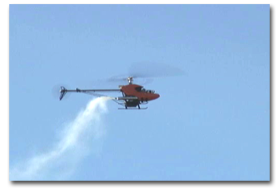All Posts (14054)
Sort by
Here's another view:
Here's the writeup from the site: $299 purchase includes: (1) RVOSD with GPS (1) Current sensor with 150 mm wire (1) Temperature sensor (1) IR remote (controls OSD menu) (3) 150mm male to male servo wires ((to connect OSD to Rx) (3) 300mm male to male servo wires (to connect OSD to Rx) (1) KX131/KX191 camera to OSD connector (1) KX171 camera to OSD connector (1) 300mm male to bare lead servo cable (for making transmitter to OSD wiring harness) Introduction: The RangeVideo on-screen display (abbreviated OSD) is a small ( 8 x 4 x 3 cm) device which overlays GPS telemetry and and other relevant data onto a live video.This device is a must have for FPV flying! ----------------------------------------------- Features: 5Hz GPS Autopilot Failsafe Navigation and battery telemetry. Multiple screens Integrated power supply and filter New features added (update Aug 4, 2008): 1. Amateur radio call sign display. 2. Way point navigation (heading and distance to waypoint) 3. Shadows added to the display
 From Yann's Techno Toy Blog ...Stanford Autonomous Helicopter Project has developed new reinforcement learning techniques to stabilize and control their helicopters. The developers have been able to teach their heli to perform just about every aerobatic figure imaginable. However, the heli has no on-board intelligence. Instead, data is fed from onboard GPS and IMU with serial outputs directly into Xbee Pro modules. The signals are received by a PC on the ground, which enables operator control via the training port of a conventional R/C transmitter.
From Yann's Techno Toy Blog ...Stanford Autonomous Helicopter Project has developed new reinforcement learning techniques to stabilize and control their helicopters. The developers have been able to teach their heli to perform just about every aerobatic figure imaginable. However, the heli has no on-board intelligence. Instead, data is fed from onboard GPS and IMU with serial outputs directly into Xbee Pro modules. The signals are received by a PC on the ground, which enables operator control via the training port of a conventional R/C transmitter.
- All four RC-in channels (plus the autopilot on/off channel) can now be read by the CPU. This allows the autopilot to read the initial throttle and rudder position when you switch to autonomous mode, so it can maintain speed and heading. The other two channels can be used for whatever you want, such as triggering a camera sequence or dropping an object. (Remember that the aileron and elevator channels are seperately controlled by the FMA Co-Pilot)
- There are now status LEDs for the failsafe (on/off) and the GPS (satellite lock).
- There is now a trim pot on the board so you can adjust the autopilot on/off position to suit your particular RC system.